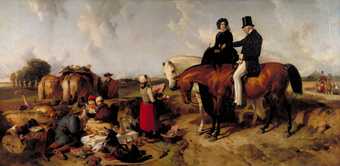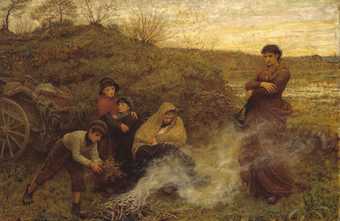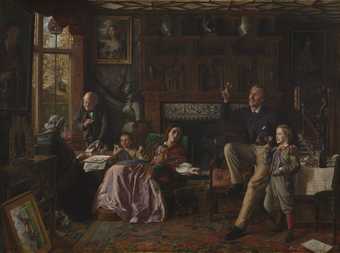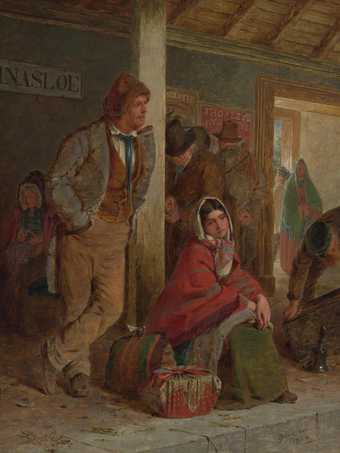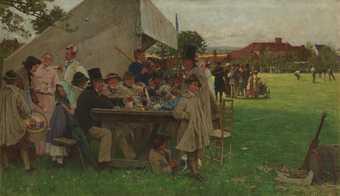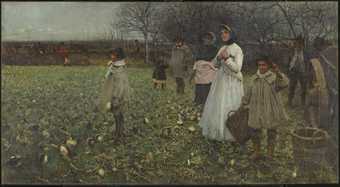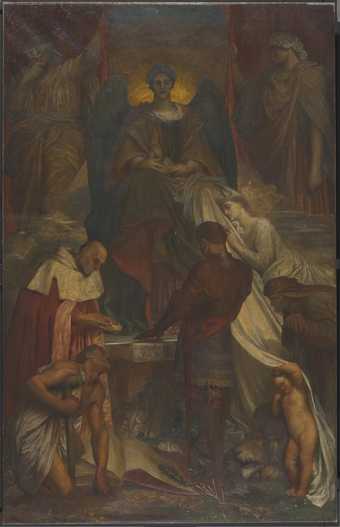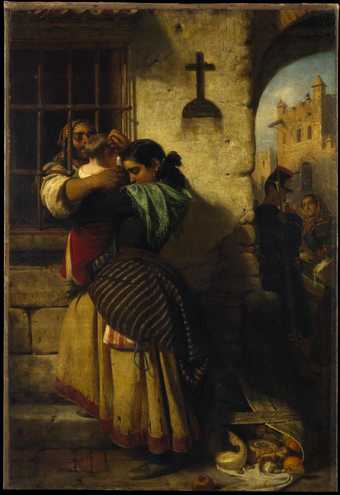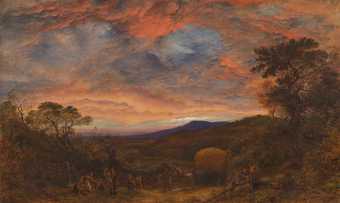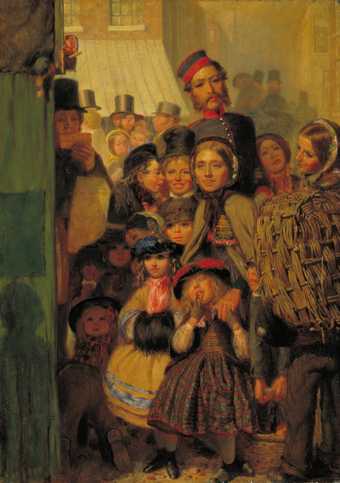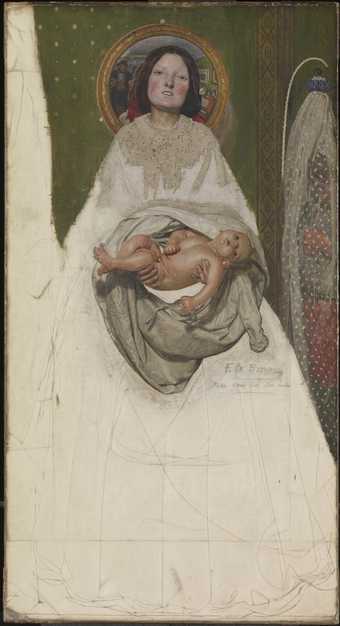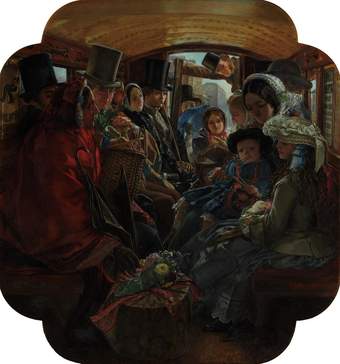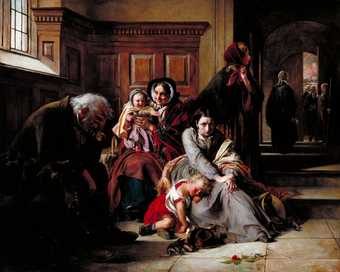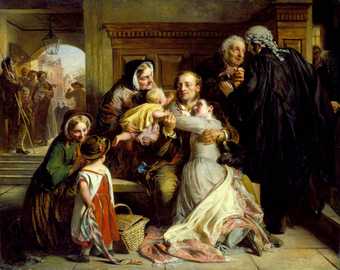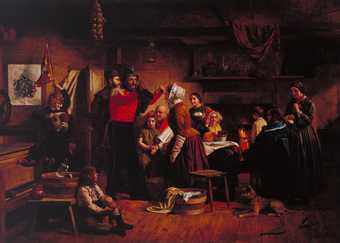
Not on display
- Artist
- Richard Redgrave 1804–1888
- Medium
- Oil paint on canvas
- Dimensions
- Support: 679 × 984 mm
frame: 872 × 1178 × 85 mm - Collection
- Tate
- Acquisition
- Purchased with assistance from an anonymous donor 1977
- Reference
- T02110
Summary
As a result of the industrial revolution, there was widespread unemployment in Britain during the 1830s and 1840s, resulting in mass emigration to the British colonies and the United States. The theme of emigration appears in several paintings and novels of the mid 19th Century, not least Ford Madox Brown's The Last of England (1852-4, Birmingham City Museum and Art Gallery), a watercolour replica of which is in the Tate collection (N03064).
A major incentive for the emigrants was the discovery of gold in Australia and North America; a fact referred to in these lines from Oliver Goldsmith's The Traveller (1764), which accompanied the picture when it was first exhibited at the Royal Academy in 1859:
Have we not seen, round Britain's people shore,
Her useful sons exchanged for useless ore?
Forced from their homes, a melancholy train,
To traverse climes beyond the western main.
Redgrave's choice of verse was severely criticised by the Illustrated London News, which complained that 'the time is gone by for such maudlin stuff as this, and artists, if they would minister to the requirements of the age in "Britain's peopled shore", and in new homes "beyond the Western main" would do wisely to adopt a more ennobling view of a great social and political movement' (quoted in Lambourne, p.359).
Redgrave was a pioneer of social realist subjects, but he later turned to landscape and frequently painted in the open air. In this work the focus is less on the unhappy family of emigrants than on the idyllic countryside they are so loath to leave. The setting is Leith Hill, near Abinger in Surrey, where Redgrave owned a cottage and spent the summer months of each year. The understated drama of the family's departure is described in bright colours and careful detail, a new development in Redgrave's art, perhaps reflecting the influence of Pre-Raphaelite art. On the opposite hill the inhabitants of the village have come out to wish them well. The father, with his carpenter's bag, 'a modern Joseph escaping with his family to a new land and life' (Casteras and Parkinson, p.138), waves his hat in an enthusiastic gesture of farewell. Underlying the family's sadness at departure is a sense of optimism, reflected in the sun-drenched countryside. Halfway down the hill a crippled boy stands forlorn, unable to accompany them on their adventure.
Further reading:
Susan P. Casteras and Ronald Parkinson (eds), Richard Redgrave 1804-1888, exhibition catalogue, Victoria and Albert Museum, London 1988, pp.137-8, no.108, reproduced p.147, in colour.
Christopher Wood, Victorian Painting, London 1999, pp.123, reproduced p.123, in colour.
Lionel Lambourne, Victorian Painting, London 1999, pp. 358-9, reproduced p.358, in colour.
Frances Fowle
December 2000
Does this text contain inaccurate information or language that you feel we should improve or change? We would like to hear from you.
Display caption
During the Industrial Revolution of the 18th and 19th centuries many British businesses began to use new manufacturing processes. The shift towards mass production in factories resulted in huge job losses. In the 1840s and 1850s many families were forced to leave Britain to look for opportunities and employment elsewhere. Redgrave was one of several artists who documented this emigration. This family is shown leaving Abinger in Surrey, where Redgrave owned a cottage.
Gallery label, July 2019
Does this text contain inaccurate information or language that you feel we should improve or change? We would like to hear from you.
Catalogue entry
T02110 THE EMIGRANT'S LAST SIGHT OF HOME 1858
Inscribed ‘Richd Redgrave 1858’ b.r.
Oil on canvas 26 3/4 × 38 3/4 (67.9 × 98.4)
Purchased from Roy Miles Fine Paintings (Grant-in-Aid) with the assistance of an anonymous donor 1977
Prov: by descent to R. N. Marshall, great-grandson of the artist; sold Sotheby's Belgravia 27 March 1973 (48, repr.in colour), bt. Roy Miles Fine Paintings.
Exh: RA 1859 (218); A Century of English Paintings, Roy Miles Fine Paintings 1973 (repr. in colour); People and Places, Roy Miles Fine Paintings 1975 (repr.); Victorian Panorama, Alexander Gallery 1976 (37, repr.).
Lit: Art Journal, 1859, p.165; Christopher Wood, Victorian Panorama: Paintings of Victorian Life, 1976, p.222, repr. in colour pl.236.
Exhibited at the Royal Academy in 1859 with the following lines printed in the catalogue under the title:
‘Have we not seen, round Britain's peopled shore,
Her useful sons exchanged for useless ore?
Forced from their homes, a melancholy train,
To traverse climes beyond the western main.’
The theme of emigration was topical in the years around 1850, during which a great number of people left Britain intending to make their fortunes overseas. The subject was debated in journals such as The Edinburgh Review (January 1850) and Household Words (30 March and 24 August 1850), and was also dealt with in literature, the most famous fictional emigré being Mr. Micawber in Dickens's David Copperfield (published 1850). Between 1848 and 1858 several paintings were shown at the Royal Academy which recorded the interest in emigration, by artists including Frederick Goodall in 1848 (‘Departure of the Emigrants’), W. S. Burton in 1849 (‘An Irish Emigrant’), James Collinson in 1850 (‘Answering the Emigrant's Letter’; he also exhibited ‘The Emigration Scheme’ at the Liverpool Academy in 1852), Thomas Webster in 1852 (‘A Letter from the Colonies’, now Tate T00046) and William Callcott in 1857 (‘Emigrant's Ship weighing Anchor’). The most famous emigration picture was not an Academy exhibit: Ford Madox Brown's ‘The Last of England’ (1852–5 and 1859, City Art Gallery, Birmingham; small replica of 1860, Fitzwilliam Museum, Cambridge; watercolour replica of 1864–6, Tate N03064). Redgrave's painting may owe something to W.S.P. Henderson's ‘The Last Look of Home’ (RA 1856 no.1199; present whereabouts unknown), particularly in view of the lines of poetry appended to the title in the catalogue:
‘Upon the hill he turn'd,
To take a last fond look
Of the village and the village church,
And the cottage by the brook.’
Redgrave's son noted that his father's later works were predominantly landscapes, ‘partly from his great love of Nature, and partly because his other duties [as an administrator of the South Kensington Museum] allowed him leisure only in the summer for working at his easel ...’ (F.M. Redgrave, Richard Redgrave: A Memoir ..., 1891, p.47). He went on to say that these landscapes ‘were painted mostly on the spot, and were true to Nature in the smallest details. As such, they were almost the only contemporary landscapes which the rising school of the “P.R.B.s” were ever known to speak well of’. The present landscape was probably painted in Surrey, where in 1856 Redgrave bought a cottage at Abinger, ‘a charming Surrey village on the slopes of Leith Hill, and the remaining summers of his life were spent in that lovely spot’ (Redgrave, 1891, p.71). Ruskin admired the ‘beautiful distance of the painting’ (Academy Notes, 1859; Library Edition XIV, 1904, p.229), and the Art Journal also remarked on the landscape: ‘In comparing the landscape portion of this picture with the figures, it appears that Mr Redgrave throws himself into the former with a fervency of devotion rarely witnessed. We press the hand of the honest emigrant, and pray God speed him on his voyage to his new home ... The severe truth that prevails throughout the description of this material ... cannot be too highly eulogised’.
Published in:
The Tate Gallery 1976-8: Illustrated Catalogue of Acquisitions, London 1979
Explore
- architecture(30,960)
-
- townscapes / man-made features(21,603)
-
- village(753)
- emotions and human qualities(5,345)
-
- sadness(202)
- clothing and personal items(5,879)
-
- umbrella(91)
- crutch(24)
- actions: expressive(2,622)
-
- waving(54)
- disability(51)
- UK cities, towns and villages(12,725)
-
- Abinger(1)
- Surrey(333)
- England(19,202)
- England, South East(5,940)
- England, Southern(8,982)
- family(602)
-
- family(1,081)
- mother and child(394)
- displacement(24)
- cart(854)
You might like
-
Sir Edwin Henry Landseer A Dialogue at Waterloo
exhibited 1850 -
Frederick Walker The Vagrants
1868 -
Robert Braithwaite Martineau The Last Day in the Old Home
1862 -
Erskine Nicol The Emigrants
1864 -
John Robertson Reid A Country Cricket Match
1878 -
John Robertson Reid Toil and Pleasure
1879 -
George Frederic Watts and assistants The Court of Death
c.1870–1902 -
John Phillip The Prison Window
1857 -
John Linnell Harvest Home, Sunset: The Last Load
1853 -
Arthur Boyd Houghton Punch and Judy
c.1860 -
Ford Madox Brown ‘Take your Son, Sir’
?1851–92 -
William Maw Egley Omnibus Life in London
1859 -
Abraham Solomon Waiting for the Verdict
1857 -
Abraham Solomon Not Guilty (The Acquittal)
exhibited 1857 -
James Collinson Home Again
1856

